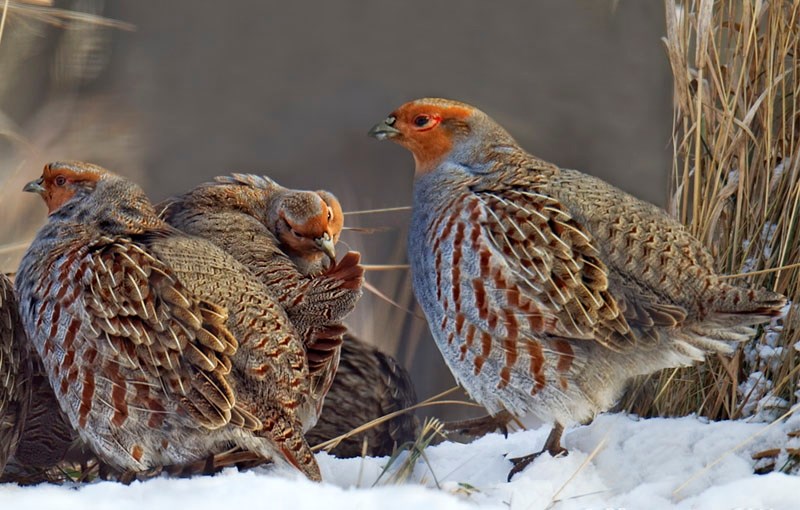The gray partridge is probably the silliest bird I’ve ever met in St. Albert. It’s the only one I know that will run, not fly, away when I approach it, zipping along on its tiny little legs until I’m out of sight. But since they often end up running alongside me, this isn’t all that effective.
Take last summer, for example. I was cruising along on my bike by the Sturgeon when I saw what looked like a duck with a bunch of brown ducklings by the trail. I slowed down and saw that it was actually a partridge with a bevy of babies. To them, I imagine, I looked a lot like the T-Rex from Jurassic Park.
The birds took off, of course, sprinting as fast as they could, while I coasted alongside them, bemused that they were keeping pace with me instead of hanging a left into the cover of the tall grass. The kids eventually ducked into hiding, but the parent didn’t, instead standing stock-still and staring in my direction, as if daring me to eat it. I wasn’t hungry.
The gray partridge is a brown or grey chicken-like bird that resembles a large quail. Look for chestnut bars on its flank, a reddish face and throat, and (in the case of males) a dark red U-shaped patch on the chest.
You’ll usually spot them near heavily grassed areas like ravines or the river valley, or in industrial areas, which have lots of tall grass and tasty bugs. They prefer farmers’ fields in the country, as those places have free food and cover for them.
Inglewood resident Steve Knight usually spots them in his backyard – he’s had about 10 to 15 camped out there each winter for the last six years. “They tend to show up around New Year’s and they stay for about four months,” he says, drawn by his many bird feeders. They’ll even stick around as he does yard work provided he moves slowly.
He says he loves the birds, and often has guests over to look at them. “It’s always great to see parts of nature in your yard.”
The Calgary Fish and Game Association introduced gray partridges to Alberta around 1908, says Alberta Fish and Wildlife biologist Gordon Court. The first 15 pairs were from Hungary, which is why locals often call these birds “huns.”
Gray partridges prefer to run rather than fly from predators in open areas, says Gary Erickson, assistant curator of ornithology at the Royal Alberta Museum. “They’re quick runners. You’ll have a hard time catching one.”
The ones I meet in town are probably used to people, he notes, which is why they don’t immediately hide when I approach; instead, they want to keep an eye on me. “They don’t do that in the country.”
A country partridge will usually hunker down in cover and keep still until you almost step on them, Erickson says, at which point they’ll burst out of hiding and fly away, usually with a loud “rick rick rick!”
The gray partridge is an exceptional flyer, says Alastair Franke, a raptor biologist and falconer at the University of Alberta, and uses its speed and agility to evade airborne predators.
During winter, Franke says, the birds burrow 10- to 15-foot-long tunnels under the snow to reach food and shelter, spending much of their time in them. “You wouldn’t even know they are there.” They also tend to congregate into large coveys, huddling together in a circle with each facing outward for warmth.
These birds tend to have huge broods, Erickson says, and lay up to 20 eggs at once. The chicks themselves are barely four centimetres tall when they hatch, making them super vulnerable to predators.
Modern agriculture has taken its toll on the partridge, Erickson continues, as it tends to mow down all the cover the birds use to breed in. He suggests leaving ditches and grass around fields untouched until after May to give the birds a hand.
As for those silly ones I met last year, the kids eventually decided I wasn’t a threat and scooted back out of the bush (almost into the path of some skateboarders). They and their parent then jogged over to their other parent in the field across the path to scoot off into Braeside – one big silly family.
Gray Partridge
Name: Perdix perdix, a.k.a. Hungarian partridge or "hun."<br />Appearance: small, chicken-like bird with brown or grey feathers, short neck, reddish head and throat, chestnut barring on flanks, and short, rounded wings. Males have a U-shaped red patch on chest. <br />Commonly seen: running, not flying, away from you. <br />Occasionally confused with: grouse which are bigger, or odd looking pigeons.<br />Fun fact: a group of partridges can be called a bevy, brace, covey, jugging or warren.
Like wildlife? So do we! Every second Wednesday the Gazette profiles a reasonably common wild creature in the St. Albert region. Birds, beasts, bugs, fish … so long as it's alive and kicking, we’ll feature it. <br /><br />Got a creature you’d like to see profiled? Send your suggestions to [email protected].




